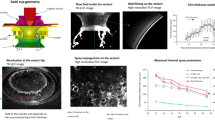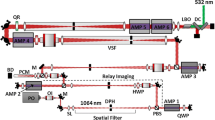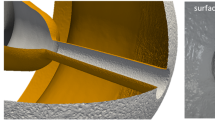Abstract
In the present study, the internal flowfield of aerated-liquid fuel injectors is examined through X-ray radiography and X-ray fluorescence. An inside–out injector, consisting of a perforated aerating tube within an annular liquid stream, sprays into a quiescent environment at a fixed mass flow rate of water and nitrogen gas. The liquid is doped with bromine (in the form of NaBr) to create an X-ray fluorescence signal. This allows for reasonable absorption and fluorescence signals, and one or both diagnostics can be used to track the liquid distribution. The injector housing is fabricated from beryllium (Be), which allows the internal flowfield to be examined (as Be has relatively low X-ray attenuation coefficient). Two injector geometries are compared, illustrating the effects of aerating orifice size and location on the flow evolution. Time-averaged equivalent pathlength and line-of-sight averaged density ρ(y) reveal the formation of the two-phase mixture, showing that the liquid film thickness along the injector walls is a function of the aerating tube geometry, though only upstream of the nozzle. These differences in gas and liquid distribution (between injectors with different aerating tube designs) are suppressed as the mixture traverses the nozzle contraction. The averaged liquid velocity (computed from the density and liquid mass flow rate) reveals a similar trend. This suggests that at least for the current configurations, the plume width, liquid mass distribution, and averaged liquid velocity for the time-averaged external spray are insensitive to the aerating tube geometry.


















Similar content being viewed by others
References
Abdulagatov IM, Azizov ND (2006) Experimental study of the effect of temperature, pressure and concentration on the viscosity of aqueous NaBr solutions. J Solut Chem 35:705–738
Berger MJ, Hubbell JH, Seltzer SM, Chang J, Coursey JS, Sukumar R, Zucker DS, Olsen K (1998) XCOM: Photon Cross Sections Database
Buckner HN, Sojka PE (1991) Effervescent atomization of high-viscosity fluids: part I, Newtonian liquids. Atomization Sprays 1:239–252
Chawla JB (1985) Atomization of liquids employing the low sonic velocity in liquid/gas mixtures. In: Proceedings of the third international conference on liquid atomization and spray systems
Dasch CJ (1992) One-dimensional tomography: a comparison of Abel, onion-peeling, and filtered backprojection methods. Appl Opt 31:1146–1152
Fabian AC, Hu EM, Cowie LL, Grindlay J (1981) The distribution and morphology of X-ray-emitting gas in the core of the Perseus cluster. Astrophys J 248:47–54
Faeth GM, Hsiang L-P, Wu P-K (1995) Structure and breakup properties of sprays. Int J Multiph Flow 21:99–127
Kastengren A, Powell CF (2014) Synchrotron X-ray techniques for fluid dynamics. Exp Fluids 55:1686. doi:10.1007/s00348-014-1686-8
Kastengren AL, Powell CF, Arms D, Dufresne EM, Wang J (2010) Spray diagnostics at the advanced photon source 7-BM beamline. In: 22nd Annual conference on liquid atomization and spray systems
Kim JY, Lee SY (2001) Dependence of spraying performance on the internal flow pattern in effervescent atomizers. At Sprays 11:735–756
Kline SJ, McClintock FA (1953) Describing uncertainties in single sample experiments. Mech Eng 75:3–8
Kush EA, Schetz JA (1973) Liquid jet injection into a supersonic flow. AIAA J 11:1223–1224
Lee J, Sallam KA, Lin K-C, Carter CD (2009) Spray structure in near-injector region of aerated jet in subsonic crossflow. J Propuls Power 25:258–266. doi:10.2514/1.36719
Lefebvre AH, Wang XF, Martin CA (1988) Spray characteristics of aerated-liquid pressure atomizers. J Propuls Power 4:293–298
Lin K-C, Kirkendall KA, Kennedy PJ, Jackson TA (1999) Spray structures of aerated liquid fuel jets in supersonic crossflows. In: AIAA Paper 1999-2374
Lin K-C, Kennedy PJ, Jackson TA (2001a) Spray structures of aerated-liquid jets in subsonic crossflows. In: AIAA Paper 2001-0330
Lin K-C, Kennedy PJ, Jackson TA (2001b) Structures of internal flow and the corresponding spray for aerated-liquid injectors. In: AIAA Paper 2001-3569
Lin K-C, Kennedy PJ, Jackson TA (2002) Structures of aerated-liquid jets in high-speed crossflows. In: AIAA Paper 2002-3178
Lin K-C, Rajnicek C, McCall J, Carter C, Fezzaa K (2010) Exploration of near-field structures of aerated-liquid jets in a quiescent environment using the X-ray technique. In: 22nd annual conference on liquid atomization and spray systems, Cincinnati, OH
Lin K-C, Carter CD, Smith S, Kastengren A (2012) Exploration of aerated-liquid jets using X-ray radiography. In: AIAA Paper 2012-0347
Lin K-C, Carter CD, Smith S, Kastengren A (2014) Characterization of aerated-liquid jets using simultaneous X-ray radiography and X-ray fluorescence measurements. In: 26th annual conference on liquid atomization and spray systems, Portland, OR
Lin K-C, Carter CD, Kastengren A, Peltier SJ (2015) Exploration of gas phase properties in aerated-liquid jets using X-ray fluorescence. In: AIAA Paper 2015-0165
Lin K-C, Peltier SJ, Carter CD, Donbar JM, Kastengren A (2016) Exploration of liquid mass distribution for liquid jets in subsonic crossflows using X-ray radiography. In: AIAA Paper 2016-1592
Linne M, Paciaroni M, Berrocal E, Sedarsky D (2009) Ballistic imaging of liquid breakup processes in dense sprays. Proc Combust Inst 32:2147–2161
Linne M, Sedarsky D, Meyer T, Gord J, Carter C (2010) Ballistic imaging in the near-field of an effervescent spray. Exp Fluids 49: 911–923
Mathur T, Lin K-C, Kennedy PJ, Gruber MR, Donbar JM, Jackson TA, Billig F (2000) Liquid JP-7 combustion in a scramjet combustor. In: AIAA Paper 2000-3581
Olinger DS, Sallam KA, Lin K-C, Carter CD (2014) Digital holographic analysis of the near field of aerated-liquid jets in crossflow. J Propuls Power 30:1636–1645. doi:10.2514/1.B34984
Pegram LM, Record MTJ (2006) Partitioning of atmospherically relevant ions between bulk water and the water/vapor interface. Proc Natl Acad Sci USA 103:14278–14281
Sallam KA, Aalburg C, Faeth GM, Lin K-C, Carter CD, Jackson TA (2006) Primary breakup of round aerated-liquid jets in supersonic crossflows. Atomization Sprays 16:657–672
Santangelo PJ, Sojka PE (1995) A holographic investigation of the near-nozzle structure of an effervescent atomizer-produced spray. Atomization Sprays 5:137–155
Sen D, Balzan MA, Nobes DS, Fleck BA (2014) Bubble formation and flow instability in an effervescent atomizer. J Vis 17:113–122. doi:10.1007/s12650-014-0196-3
Sovani SD, Sojka PE, Lefebvre AH (2001) Effervescent atomization. Prog Energy Combust Sci 27:483–521
Wade RA, Weerts JM, Sojka PE, Gore JP, Eckerle WA (1999) Effervescent atomization at injection pressures in the MPa range. Atomization Sprays 9:651–657
Whitlow JD, Lefebvre AH (1993) Effervescent atomizer operation and spray characteristics. Atomization Sprays 3:137–155
Wu P-K, Ruff GA, Faeth GM (1991) Primary breakup in liquid/gas mixing layers. In: AIAA Paper 1991-0285
Acknowledgements
This work was sponsored by the AFRL/Aerospace Systems Directorate (Contract monitor: Steve Smith) and by the Air Force Office of Scientific Research (AFOSR). This research used resources of the Advanced Photon Source, a U.S. Department of Energy (DOE) Office of Science User Facility operated for the DOE Office of Science by Argonne National Laboratory under Contract No. DEAC02-06CH11357.
Author information
Authors and Affiliations
Corresponding author
Appendix: Uncertainty Quantification
Appendix: Uncertainty Quantification
The uncertainty of the EPL and the resulting derived quantities (line-of-sight averaged density and average liquid velocity) are computed from the procedure of Kline and McClintock (1953), in which the principal uncertainties are weighted by the respective sensitivity coefficients and combined as a root-sum-of-squares. As described in Sect. 2.4, the EPL of the two-phase mixture is found by removing the attenuation through the beryllium injector body:
where the subscript corr indicates the corrected intensity ratio, and meas is the measured value. The uncertainty can, therefore, be calculated as
The uncertainties for (I/I 0)meas and (I/I 0)Be are computed in a similar fashion, using the previously described procedure from Sect. 2.4 to compute (I/I 0)Be:
and
Note that the uncertainty in Eq. (9) is a function of the chord length z Be through the injector body, computed as
where R 1 and R 2 are the outer and inner radii of the injector body, respectively. Using the principal uncertainty values in Table 2, the uncertainty of EPL can be calculated (Fig. 19). In the aerating region for Case A, the uncertainty increases from nominally 1–7% as the two-phase mixture flows downward toward the mixing region.
The uncertainty of the line-of-sight averaged density ρ(y) is computed by applying the above procedure to Eq. (3), leading to
Due to the iterative nature of the signal trapping fluorescence correction, a closed-form solution for Eq. (7) was not available for the nozzle and spray regions. Instead, Eq. (11) was calculated by estimating ε EPL as 2% of the local value, based upon inspection of the aerating and mixing regions. The density uncertainty in the aerating region has been shown in Fig. 10, depicting the elevated uncertainty levels near the injector wall. This trend is attributed to the uncertainty of D(y) shown in Fig. 20, which increases as y approaches R 2.
The axial velocity uncertainty ε u is computed from Eq. (4) as
where the uncertainty of the TIM is
The spanwise spacing of the measurement locations is represented by Δy. Figure 17 shows the uncertainty plotted as error bars, indicating that the uncertainty is approximately 10% of the local velocity for most locations. The magnitude of the uncertainty can be explained by D(y) (Fig. 20). Due to the summation in Eq. (4), the uncertainty of TIM is biased towards larger values by the elevated uncertainty of D(y) at the periphery of the measurement region.
Rights and permissions
About this article
Cite this article
Peltier, S.J., Lin, KC., Carter, C.D. et al. Characterization of the external and internal flow structure of an aerated-liquid injector using X-ray radiography and fluorescence. Exp Fluids 58, 111 (2017). https://doi.org/10.1007/s00348-017-2380-4
Received:
Revised:
Accepted:
Published:
DOI: https://doi.org/10.1007/s00348-017-2380-4






